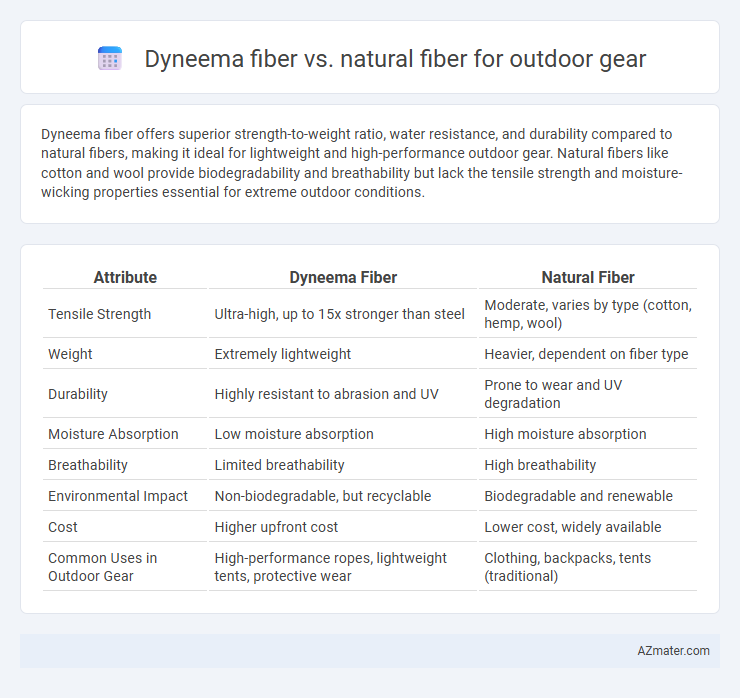Dyneema fiber offers superior strength-to-weight ratio, water resistance, and durability compared to natural fibers, making it ideal for lightweight and high-performance outdoor gear. Natural fibers like cotton and wool provide biodegradability and breathability but lack the tensile strength and moisture-wicking properties essential for extreme outdoor conditions.
Table of Comparison
| Attribute | Dyneema Fiber | Natural Fiber |
|---|---|---|
| Tensile Strength | Ultra-high, up to 15x stronger than steel | Moderate, varies by type (cotton, hemp, wool) |
| Weight | Extremely lightweight | Heavier, dependent on fiber type |
| Durability | Highly resistant to abrasion and UV | Prone to wear and UV degradation |
| Moisture Absorption | Low moisture absorption | High moisture absorption |
| Breathability | Limited breathability | High breathability |
| Environmental Impact | Non-biodegradable, but recyclable | Biodegradable and renewable |
| Cost | Higher upfront cost | Lower cost, widely available |
| Common Uses in Outdoor Gear | High-performance ropes, lightweight tents, protective wear | Clothing, backpacks, tents (traditional) |
Introduction to Dyneema and Natural Fibers
Dyneema fiber, a high-performance ultra-high-molecular-weight polyethylene (UHMWPE), offers exceptional strength-to-weight ratio and superior abrasion resistance, making it ideal for demanding outdoor gear applications like backpacks, tents, and climbing ropes. Natural fibers such as cotton, hemp, and wool provide breathability, biodegradability, and comfort but lack the tensile strength and durability required for extreme outdoor conditions. The combination of Dyneema's lightweight durability and natural fibers' environmental benefits shapes modern outdoor gear innovations.
Strength and Durability Comparison
Dyneema fiber offers exceptional tensile strength, boasting a strength-to-weight ratio up to 15 times greater than steel, making it significantly more durable than natural fibers such as cotton or hemp. Its high resistance to abrasion, UV exposure, and moisture ensures prolonged longevity in harsh outdoor environments compared to natural fibers that degrade faster when exposed to the elements. This combination of lightweight durability and resilience makes Dyneema the superior choice for high-performance outdoor gear designed for extreme conditions.
Weight and Packability Differences
Dyneema fiber offers exceptional strength-to-weight ratio, making outdoor gear significantly lighter compared to natural fibers like cotton or wool, which are denser and heavier. Its high tensile strength allows for thinner, more compact designs, enhancing packability without compromising durability. Natural fibers, while breathable and biodegradable, tend to absorb moisture and increase in weight, reducing overall efficiency for backpacking and climbing gear.
Water Resistance and Weather Performance
Dyneema fiber offers superior water resistance compared to natural fibers like cotton or wool, making it ideal for outdoor gear exposed to wet conditions. Its hydrophobic properties prevent water absorption, ensuring lightweight performance even in heavy rain, while natural fibers tend to retain moisture and dry slowly. Dyneema's exceptional weather performance includes resistance to UV degradation and mildew, enhancing durability and longevity in various outdoor environments.
Environmental Impact and Sustainability
Dyneema fiber offers exceptional strength-to-weight ratio and durability, significantly reducing the need for frequent replacement of outdoor gear, which lowers long-term environmental impact. Natural fibers like cotton, hemp, and wool are biodegradable and renewable, but often require more water, land, and pesticides in cultivation, contributing to higher ecological footprints compared to Dyneema's production process. The biodegradability of natural fibers contrasts with Dyneema's synthetic, non-biodegradable nature, posing challenges for end-of-life disposal and recycling in outdoor gear applications.
Cost and Accessibility
Dyneema fiber offers superior strength-to-weight ratio and durability for outdoor gear but comes at a significantly higher cost compared to natural fibers like cotton or hemp. Natural fibers are widely accessible, biodegradable, and budget-friendly, making them preferred for eco-conscious consumers and casual outdoor use. However, Dyneema's premium price limits its availability primarily to specialized markets requiring extreme performance and lightweight materials.
Comfort and Breathability
Dyneema fiber offers exceptional durability and lightweight strength but lacks the natural breathability and moisture-wicking properties found in natural fibers like cotton and wool, which are preferred for comfort in outdoor gear. Natural fibers provide superior air circulation and temperature regulation, reducing sweat buildup and enhancing comfort during extended wear in varying climates. Balancing Dyneema's rugged performance with natural fibers can optimize both protection and breathability for outdoor enthusiasts.
Maintenance and Care Requirements
Dyneema fiber requires minimal maintenance due to its high resistance to moisture, UV rays, and abrasion, making it ideal for prolonged outdoor use with simple cleaning techniques like rinsing with cold water. In contrast, natural fibers such as cotton or wool demand more careful handling, often requiring gentle washing and thorough drying to prevent mold, shrinkage, and degradation from environmental exposure. The low-maintenance nature of Dyneema fiber significantly extends the lifespan of outdoor gear while reducing the need for frequent replacements or repairs.
Common Outdoor Applications
Dyneema fiber, known for its exceptional strength-to-weight ratio and high resistance to abrasion, is widely used in outdoor gear such as backpacks, ropes, and tents where durability and lightweight performance are critical. Natural fibers like cotton and hemp offer breathability and biodegradability, making them common choices for clothing and some camping accessories but generally lack the tensile strength required for high-stress applications. In demanding environments, Dyneema's water resistance and UV stability make it ideal for technical gear, whereas natural fibers are preferred for comfort-focused items.
Choosing the Right Fiber for Your Needs
Dyneema fiber offers exceptional strength-to-weight ratio, superior abrasion resistance, and water repellency, making it ideal for high-performance outdoor gear requiring durability and lightweight properties. Natural fibers such as cotton or hemp provide breathability, biodegradability, and comfort but lack the tensile strength and moisture resistance needed for extreme conditions. Choosing the right fiber depends on prioritizing factors like durability, environmental impact, weight, and intended outdoor activity demands.

Infographic: Dyneema fiber vs Natural fiber for Outdoor gear
 azmater.com
azmater.com